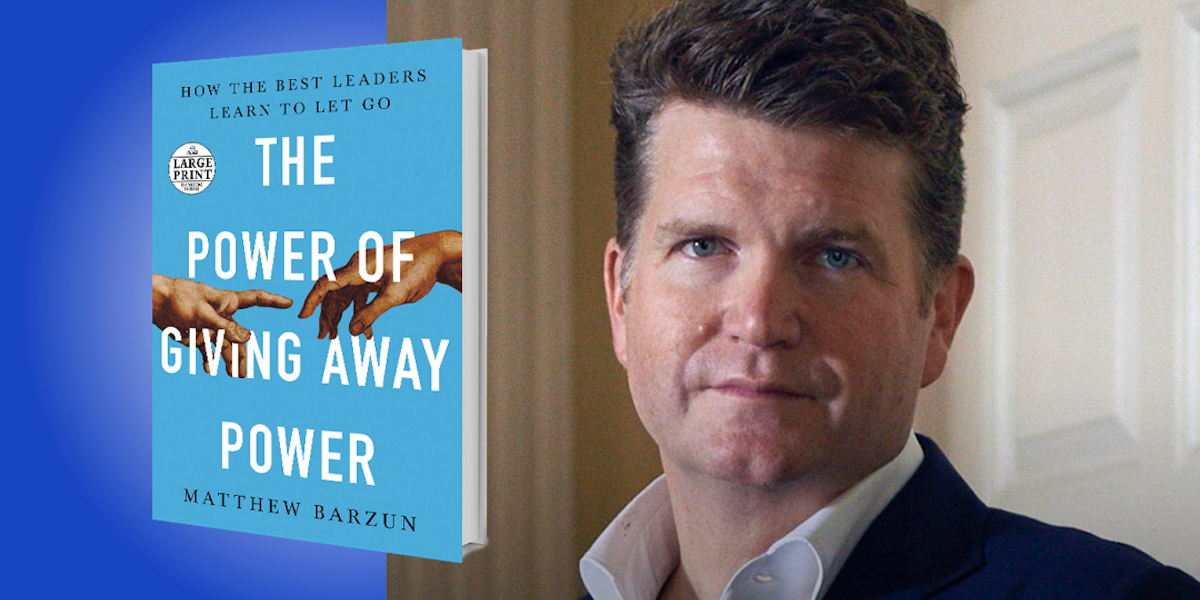Matthew Barzun has always been fascinated about how we can stand out and fit in at the same time. He helped countries do both when he served as US ambassador to the United Kingdom and to Sweden. He helped citizens do both as National Finance Chair for Barack Obama by pioneering new ways for people to have a stronger voice in politics. And he helped tech consumers do both as an entrepreneur when he helped build CNET Networks in the early 90’s.
Below, Matthew shares 5 key insights from his new book, The Power of Giving Away Power: How the Best Leaders Learn to Let Go (available now from Amazon). Listen to the audio version—read by Matthew himself—in the Next Big Idea App.
1. The Pyramid Trap.
We’ve all gotten the memo that “top-down” leadership isn’t working. No more barking down orders from the top of the pyramid, right? So many of us have turned to what we think is the opposite: “bottom-up” leadership. But a bottom-up perspective forces you into one of only two choices—you are either looking at those around you as beneath you, or you’re seeing yourself as beneath someone else. In either case, we are reinforcing the exact same pyramid shape we’d hoped to escape. It’s hierarchy by a different name.
This hierarchical way of thinking has infiltrated how we see almost everything. If you ask a group of ten people, “What’s the opposite of winning?”, they all say “losing.” Then if you ask, “what’s the opposite of winning and losing?”, nine out of ten will say something like, “I don’t know, sitting it out?” One in ten of us says “playing,” or “being,” or “loving,” or “learning,” or any of the other things we enjoy that aren’t strictly winning and losing. The things we value most in life—marriage, careers, friendship, parenting—these are things you cannot win.
“The things we value most in life—marriage, careers, friendship, parenting—these are things you cannot win.”
With this in mind, we can find our way out of the pyramid trap. And once we do, we can start to see the alternative, which has a symbol of its own.
2. The Lost Constellation.
On July 4th, 1776, there were two, not one, declarations made in Philadelphia. In addition to the famous Declaration of Independence, the founders that day also declared, in a move familiar to startups everywhere, “We need a logo.” This would become the two-sided Great Seal of the United States, and you can see both sides of it today on the back of a dollar bill.
They chose an American eagle with a shield, and also decided on a motto—E pluribus unum (from many, one)—and they picked a design for the back side of the seal. For the crest on the front, they chose 13 stars of different sizes in an asymmetrical pattern, with beams of light emanating outward. They called it the “radiant constellation.” It symbolized the animating idea of this new country: independent bodies freely choosing to behave in concert to accomplish something bigger, more useful, more powerful than each could alone. One could stand out on one’s own—like a star—but at the same time be part of a larger unit—a constellation. Any band of revolutionaries can declare independence, but this constellation symbol pointed toward something harder and much more meaningful: interdependence.
Now, a pyramid does appear on the back of the seal, symbolizing the top-down form of power that should be used only when necessary. But today, we keep putting the idea of the pyramid (up/down, in/out, win/lose) at the forefront of our lives, in business, politics, and diplomacy. Yet it’s the constellation that was America’s best idea. “From many, one” was not meant to mean “from many bricks, one pyramid.” It means “from many stars, one constellation”—where fitting in never means losing your identity, and being a one-of-a-kind individual doesn’t mean going it alone. In a constellation, you can stand out and fit in.
“In a constellation, you can stand out and fit in.”
3. Don’t compromise.
Peter Drucker, leadership guru of leadership gurus, once revealed that he, too, had a guru: Mary Parker Follett, who was born in 1868 outside of Boston, and died in 1933. Follet’s great insight was that we could start to heal societal divisions by thinking quite small. The power of interdependence—what I call “constellation power”—could be rekindled, she thought, by focusing on how people engaged with one another in small groups around a table. In other words, power could be made in every single meeting we attend.
She explained that there are four possible outcomes for any meeting, only one of which is worthwhile:
- Bad outcome #1: Win. Your idea prevails over all others’—but everyone else loses. So why even have them at the meeting?
- Bad outcome #2: Acquiesce. You say, “John seems super pushy, and it’s not worth the fight.” That’s not okay because you’ve deprived the group of your unique perspective.
- Bad outcome #3: Compromise. For Follett, that was just the sum of partial wins and losses. You only got part of what you wanted, but nothing more.
The 4th possibility, and the only worthwhile one, is co-creation, making something together. That should be the aspiration of every meeting, in which everyone contributes a smart part, and the combined, bigger creation at the end is forever part of you.
To make that happen, each participant needs to come to the table with a particular mindset based on three expectations: You should expect to need others, you should expect to be needed, and you should expect to be changed. This third expectation is critical—yes, you need to bring your full self to each meeting, but you have a reciprocal obligation to leave that meeting just a little bit different. That’s how you make power—and it all begins by giving it away.
“What we really want and need isn’t total freedom or total togetherness—it’s ‘freedom together.’”
4. Stop helping.
We tend to think that every action is either selfish or selfless, but there’s a third option that we need more of right now. I can best sum it up with a story I learned from a remarkable leader in rainforest preservation named Lynne Twist.
She tells about her grueling four-day trek to the headwaters of the Amazon to meet with a tribal chief there, whose people are threatened by deforestation. She wants to see if there might be a way for her organization to help. She sits down with the chief and explains why she’s there, and the chief listens respectfully through an interpreter. And then he says back to Lynn: “I think I understand. If you’re here to help, please leave.”
Then he continues: “But… if you’re here because your liberation is inexorably tied up with our liberation, then let’s see if we can work together.”
I love that story, because it points us to an alternative to this trap of selfish vs. selfless. This is a third alternative—mutual liberation. Great energy and power lives there. Because the “freedom” instinct, when taken to its logical extreme, is total independence. And the “together” instinct, when taken to its logical extreme, means that individual identity is absorbed by and lost in the collective. But what we really want and need isn’t total freedom or total togetherness—it’s “freedom together.”
“Like real-life light bulbs, people need energy and a connection to work.”
5. Leadership is a joke.
A great stand-up comedian once told me, “Jokes are strange things. If you sing a song and nobody claps, it’s still a song. But if you tell a joke and nobody laughs, it’s just a sentence.” To me, that was profound. A joke isn’t just the delivery of the words—it’s the connection, a completed circuit. The comedian does his or her part, the audience does theirs, and together they make something new.
It’s the same with leadership—it has to connect and create something new with other people. Otherwise it’s just sentences. In this way, good leadership should be like a good joke.
We say that great leaders “light up a room.” We think of this great, glowing leader all alone, beaming their light onto and off of each of us. The image is so representative of our instinct to isolate—to factor out our interdependence, to think we can do things all by ourselves. But like real-life light bulbs, people need energy and a connection to work. So when a leader “lights up a room,” that should be because they have made connections such that everyone’s individual lights turn on. That’s how leaders can “light up a room” in the right way.
To listen to the audio version read by Matthew Barzun, download the Next Big Idea App today:





























